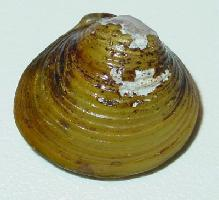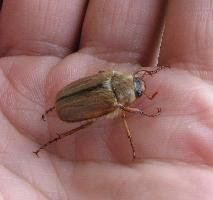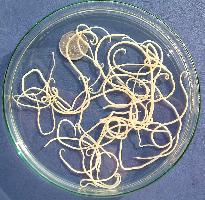
Greutăți și măsuri
| Lungime | de la 38 la 50 mm |
|---|
Descrierea animalului
The Asian clam, scientifically known as Corbicula fluminea, is a species of freshwater clam native to Asia, Australia, Africa, and parts of Europe. This bivalve mollusk has garnered attention for its remarkable adaptability, allowing it to thrive in a wide range of environmental conditions. This adaptability, combined with a high reproductive rate, has facilitated its spread to many parts of the world, often categorized as an invasive species outside its native range.Physically, Corbicula fluminea is relatively small, with adult shells typically ranging from 2 to 5 centimeters in length, although sizes can vary based on environmental conditions. The shell is composed of two hinged parts, known as valves, which are usually light yellow to brown in color, with concentric ridges or rings that can be felt and seen on the surface. These ridges are a record of the clam's growth, with each ring representing a period of life. The interior of the shell is smooth, often exhibiting a pale purple or pink hue.
Asian clams possess a unique feeding mechanism; they are filter feeders, drawing water into their bodies through an incurrent siphon, filtering out plankton and detritus for nourishment, and then expelling the filtered water through an excurrent siphon. This method of feeding not only sustains the clam but also plays a role in water purification by removing suspended particles from the water.
One of the most notable aspects of Corbicula fluminea is its reproductive strategy. It exhibits both sexual and asexual reproduction, with the latter allowing for rapid population growth and colonization. In warmer climates, it is capable of reproducing multiple times a year, with each adult releasing hundreds to thousands of offspring, known as juveniles or larvae. This high reproductive rate, combined with a generalist diet and tolerance for various water conditions, makes the Asian clam a successful invasive species in many regions.
Ecologically, the introduction of Corbicula fluminea to non-native environments can have significant impacts. In ecosystems where it becomes established, it can outcompete native bivalves for food and habitat, leading to declines or displacement of indigenous species. Additionally, its filter-feeding can alter water clarity and nutrient dynamics, potentially affecting the overall health of aquatic ecosystems. Furthermore, in areas such as North America and Europe, dense populations of Asian clams have been known to clog water intake pipes for power plants and other industrial facilities, leading to costly maintenance and operational challenges.
Despite these challenges, Corbicula fluminea has also been utilized by humans in various ways. In its native range and in some areas where it has been introduced, the Asian clam is harvested for food and is considered a delicacy in some cultures. Additionally, its presence in water bodies is sometimes used as an indicator of water quality, given its sensitivity to pollution and environmental changes.
In summary, the Asian clam, Corbicula fluminea, is a small but ecologically significant freshwater bivalve known for its adaptability, high reproductive rate, and filter-feeding capabilities. While it is valued in some contexts for its culinary uses and role in water purification, its invasive potential and impact on native ecosystems and human infrastructure pose ongoing challenges for management and conservation efforts.
Animale similare
Fotografii noi cu animale
Top 10 animale
- Dolphin gull (Leucophaeus scoresbii)
- Diana monkey (Cercopithecus diana)
- Moustached guenon (Cercopithecus cephus)
- Galápagos tortoise (Geochelone nigra complex)
- Russian tortoise (Testudo horsfieldii)
- Stone loach (Barbatula barbatula)
- Japanese macaque (Macaca fuscata)
- Greek tortoise (Testudo graeca)
- Common flying dragon (Draco volans)
- Vendace (Coregonus albula)


